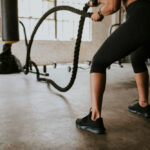Lunges are already one of the most effective lower-body moves out there, but throw in a resistance band, and you’ve got a portable, joint-friendly workout that bites way harder than it looks. Whether you’re training at home, in a hotel room, or just don’t feel like wrangling dumbbells, these resistance band lunges will challenge your legs, glutes, and core in all the right ways. Let’s break it down.
Why Lunges Are Still King Without Weights
Lunges don’t need a heavy weight to be effective. At their core (literally), they’re a powerhouse move for building strength, balance, and mobility, especially when you train one leg at a time.
Unilateral movements like lunges force your body to stabilize. That means your core works harder, your balance gets tested, and muscle imbalances get exposed (and corrected). Even without traditional weights, your body still fights gravity and, if you’re smart about band placement, tension from multiple directions.
And resistance bands? They’re not a downgrade. They’re a secret weapon. Bands provide variable resistance, which means the tension increases as you stretch them. That translates to more muscle engagement at the top of the movement.
3 Best Resistance Band Lunges
Here are resistance band lunge variations that you should try:
Reverse Lunge with Resistance Band
This one’s a staple. Loop the band under your front foot and hold the other end at shoulder height. Step back into a lunge and drive through your front heel to return.
Why it works: It’s easier on the knees and emphasizes glute and hamstring activation.
Forward Lunge with Front-Loaded Band
Loop the band under your back foot and hold it at your shoulders like a front rack. Lunge forward and let the band tension pull you slightly off balance — your core will light up.
Why it works: It smokes your quads, teaches control, and builds strong posture from the ground up.
Split Squat (Bulgarian Style) with Band
Anchor one foot behind you on a bench or chair. Loop the band under your front foot and hold it with both hands at your sides or shoulders.
Why it works: Static position = constant tension. Your glutes, quads, and stabilizers have no break, especially if you slow down the tempo.
Pro Tips to Maximize Your Band Lunges
Just because you’re using bands doesn’t mean you can slack on form or intensity. In fact, the details matter more. Here’s how to get the most out of every rep:
Slow Down – Tension Is Everything
Bands don’t work if you fly through the reps. The magic is in controlled movement. Go slow on the way down, pause at the bottom, and drive up with purpose. Time under tension = more gains.
Watch Your Knee Tracking
Your front knee should stay in line with your toes, not collapse inward. This protects your joints and keeps the effort where it belongs: your quads, hamstrings, and glutes.
Keep Your Torso Tall and Core Tight
No hunching. No leaning. Your upper body should be upright, chest lifted, and abs braced, especially when the band pulls against you.
Play With Progressions
Feeling too comfortable? Level up:
- Use a shorter band for more resistance
- Double loop it
- Add a pulse at the bottom
- Slow down the tempo
- Add an isometric hold mid-rep
Use Them Strategically
Resistance band lunges aren’t just a backup plan. Use them:
- As a warm-up for heavy lifts
- As a burnout finisher
- In circuits for metabolic conditioning
- On travel days or low-equipment workouts
Final Thoughts
Resistance band lunges deliver intensity, control, and results, all without the bulk. Whether you’re chasing muscle, better balance, or just a smarter way to train, these variations have you covered. So next time leg day rolls around and the dumbbells are nowhere in sight, grab a band and get to work.





